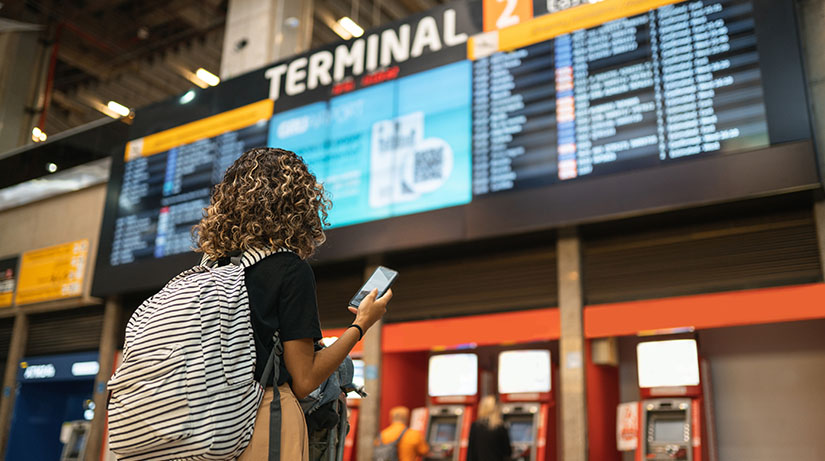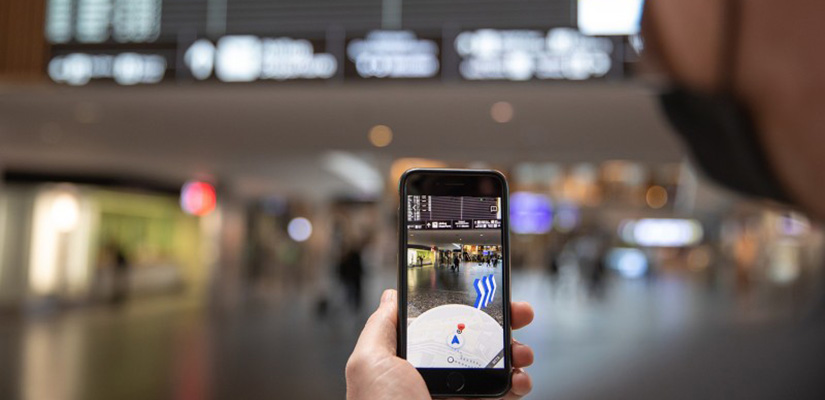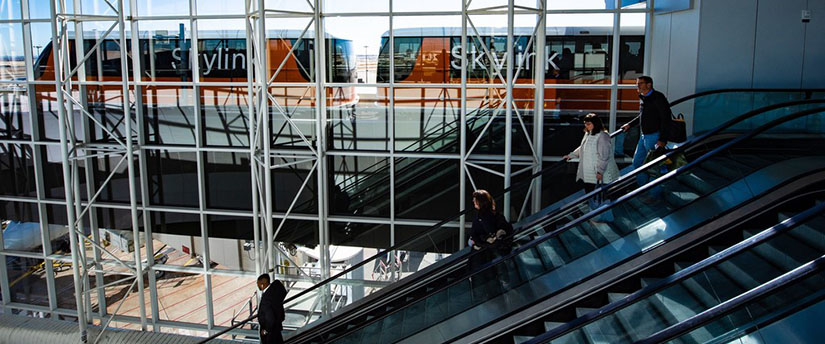NREL Study Shows Airport Energy Savings in Surprising Places: How You Find Your Way Around

As you walk through the airport's glass doors, your phone buzzes. You open the camera, hold it in front of you, and spin a slow 360 degrees. When you look at your phone screen, bright, translucent arrows overlay the ground in front of you, guiding you through the revolving doors and pointing you to the airport's security checkpoint. As you move through the terminal, the digital arrows steer you down a corridor, onto a train, up an escalator, and finally to your gate, where your plane is almost ready to board.
This experience, called "augmented reality navigation," is just one of a host of emerging digital technologies that aim to make passengers' travel through airports more equitable and energy-efficient—not to mention more convenient.
And these futuristic technologies take center stage in a new, comprehensive analysis by National Renewable Energy Laboratory (NREL) researchers that aims to reimagine how sustainability figures into the way people travel to (and through) enormous facilities like airports.
Building Greener Airports by Understanding People
"When people think of renewable energy, they don't always think about mobility systems or behavioral science. Our team studies both," said NREL's Stan Young, an advanced transportation and urban scientist who was part of the project's research team.
"We combine field observations, data, and analysis to understand how people will respond to new sustainable mobility options and make sure that new technologies will actually meet their needs and become something they want to adopt," Young continued. "In 2015, we began studying this in the context of cities and public spaces. That includes airports and air mobility. Airports are so economically vibrant and vital that they tend to be ground zero for new technologies."
That focus led the team to partner with Dallas-Fort Worth International Airport (DFW) on their ambitious goal to achieve net-zero carbon emissions with no offset credits by 2030.
The report, one of a longstanding series of NREL/DFW collaborations, details five major paths the airport could take to build a more sustainable, equitable, and convenient "transportation ecosystem" for travelers and employees at the nation's second-busiest airport. Wayfinding, the process of using information systems to move through a facility, is just one piece of the report.
The main thrust of the research is this: By considering every aspect of how people travel through airports—from moving through security to accessing different terminals—airports can create opportunities to integrate new, fuel-efficient technologies to reduce the carbon footprints of their operations, buildings, and transportation.
And wayfinding, the digital and physical information systems that guide passengers through a facility, could be a critical component of an airport's transformation.
"The concept of wayfinding has a technological aspect," Young explained. "But it also involves a change of philosophy. Wayfinding used to be done with static signs and information kiosks staffed by airport employees. We're seeing now that wayfinding technologies need to be wedded with information systems and smartphones so you can find your way around a massive facility and all of the transportation options therein."
For Airports, More Is Not Always Better
At the core of the sustainable mobility discussion, at least for DFW, is the airport's enormous scale. Spanning five half-moon-shaped terminals and with plans to build a sixth, the airport covers 27 square miles—more than the island of Manhattan—and has its own zip code and city designation.

"The size of the DFW facility is fundamentally breaking some of our architectural boundaries," Young said, referring to the "quarter-mile standard," which is frequently used to design walkable public transportation systems.
"When people can't get to their plane on time because of the size of an airport, that creates inefficiencies, and inefficiencies waste resources," Young continued, explaining that simply cutting down on travel delays can create fuel savings—measured in both dollars and carbon emissions—for airports.
Although there are many causes for flight delays, ensuring passengers get to their gates on time can improve operational efficiency, he said. When idling, a typical aircraft burns about three gallons of jet fuel per minute. Passenger mobility improvements can contribute to reduced delays and aircraft idling time, and, at a national scale, this could result in substantial fuel savings while enhancing passenger experiences.
And digital wayfinding technologies, the researchers found, can contribute to these improvements.
In their analysis, the NREL research team points to several potential wayfinding strategies. Several large technology companies are already piloting interior building navigation, similar to an indoor GPS, that works on regular smartphones. In 2020, Indoor Google Maps launched an augmented reality tool called Live View that compares what a smartphone camera "sees" to a database of facility images, then superimposes directional arrows on the camera image. That same year, Zurich Airport in Switzerland partnered with Google Maps to become the first airport to offer an indoor live view.
Other airports and technology companies are working to deploy Bluetooth low-energy beacons in a bid to advance indoor positioning technology. In the same way that beacons aid outdoor GPS navigation, indoor beacons could, with permission, sense a passenger's trajectory through a facility and send them navigation instructions based on where they are and where they are headed, from their gate or baggage carousel to a coffee shop or ATM.
These technologies are not only useful for helping travelers move more efficiently. They may also support the adoption of the state-of-the-art transportation systems powered by renewable energy proposed in the NREL team's report, which aim to become more convenient than traditional travel to the airport. Some of the technologies envisioned for the near future include self-parking car technologies at drop-off zones so passengers can disembark while their vehicle parks itself, and on-demand, automated, electric transit shuttles to easily move between airport facilities. Digital wayfinding technologies that help guide travelers to connect between mode options, explain their function and use, and inform passengers where and when they will arrive may help to increase the use of this cutting-edge, energy-efficient technology.
Equitable Airport Travel for All
These technologies, the researchers note, can also address the needs of an often-overlooked population: people with reduced mobility.
"A 20-minute walk through an airport to a particular gate is not possible for every person who travels," said NREL's Andrew Duvall, a transportation behavior analyst who was part of the research team.

Duvall pointed to the fact that many people who travel through airports have mobility limitations that require them to use elevators, escalators, or ramps. They may be traveling with young children or with a companion who has reduced mobility. English may not be their first language, and it may be too confusing to navigate the facility. For all these reasons and more, the researchers are focused on strategies to connect travelers, point-by-point, through a large facility in a way that is equitable, accessible, and convenient for all.
"At the center of this research is improving equity of access for those with the least mobility. But it also has benefits for everyone else," Duvall said. "If you design for the people with the least mobility, you also create benefits for everyone using the system."
Of course, to fully decarbonize an entire airport, more efficient wayfinding is only one piece of the puzzle.
Young pointed to the need for large facilities like airports to create "horizontal movement solutions" that efficiently move and direct people—and also integrate sustainability into their design. Those solutions, he said, may require re-envisioning systems from the bottom up. For instance, the researchers found that DFW's Skylink train is a significant asset: It connects passengers who have cleared security within all five terminals. But the system is cost prohibitive, space prohibitive, and its route cannot be easily adjusted to accommodate the airport's growth. Researchers project that the next generations of such trains will need to leverage autonomous and electric technologies to help airports meet renewable energy goals.
"Modern technology is giving us tools to create efficient, flexible systems that surpass last-century workhorses," Young said. "These are the technologies that will allow us to create efficient and equitable solutions for the next generation of facilities."
Learn more about NREL's sustainable transportation and mobility research and its specific focus on sustainable aviation. And sign up for NREL's quarterly transportation and mobility research newsletter, Sustainable Mobility Matters, to get the latest news.

